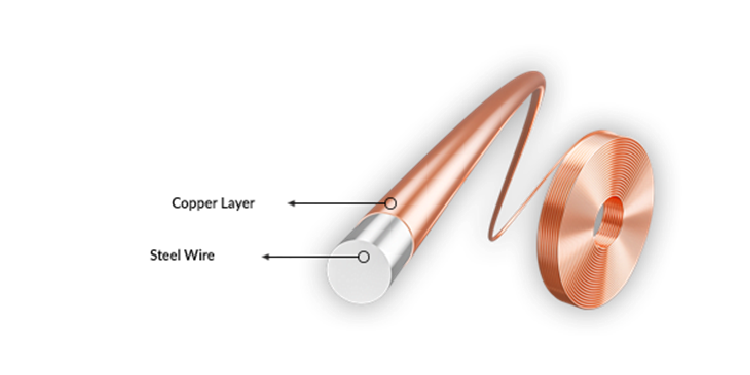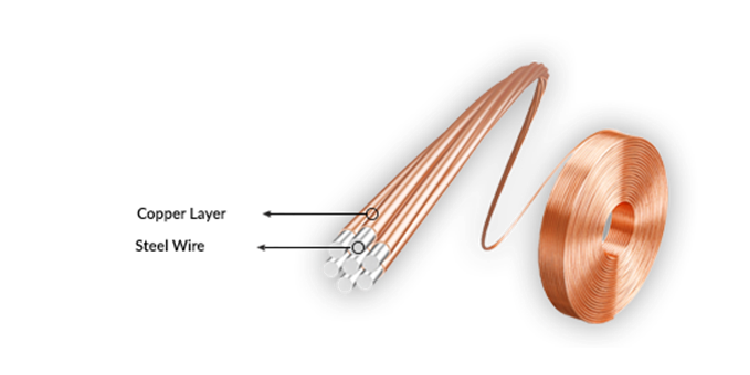Copper-clad steel (CCS)


This wire combines the strength of steel with the conductivity of copper. It is available in different configurations, including 3 strands, 7 strands, and 19 strands.
3-strand wire
- This wire is strong and flexible. It is suitable for many basic applications. The 3-strand design allows for easy handling. It is often used in grounding systems. This wire provides reliable electrical connections. It also works well in outdoor settings.
7-strand wire
- This wire offers more flexibility than the 3-strand version. The additional strands allow for better bending. The 7-strand wire is often used in telecommunications. It connects various devices effectively. Its strength and conductivity ensure reliable performance.
- Easy to install.
19-strand wire
- The most flexible and versatile.
- Suitable for complex applications.
- provide excellent conductivity.
- Handles higher electrical loads.
- Ideal for industrial applications.
General advantages
- Resistant to corrosion
- Ideal for outdoor use.
- Withstands harsh weather conditions.
- Long lifespan. Users can rely on this wire for many years.
- Low/No scrap value (less than R1/kg).
- Mechanical/Chemical etching required for separation.
Copper-clad aluminium (CCAA)


This innovative composite material combines the advantages of copper and aluminium, creating a solution that is both efficient and cost-effective.
- Exceptional electrical conductivity.
- The copper layer firmly bonds to the aluminium core.
- This provides a highly efficient pathway for the transfer of electrical signals.
- The copper layer enables efficient power transmission.
- Exhibits substantially lower resistance, reducing power losses and improving overall system efficiency.
- Lightweight compared to copper.
- Excellent corrosion resistance.
- It can also be easily cut and joined.
- More cost-effective compared to pure copper.
The copper layer acts as a protective barrier, shielding the underlying aluminium from the harmful effects of environmental factors, such as moisture, chemicals, and atmospheric pollutants. This enhanced corrosion resistance extends the lifespan of copper-clad aluminium components, reducing the need for frequent maintenance and replacement, ultimately leading to cost savings over the long term. Copper-clad steel wire is essential for lightning protection systems. This wire combines the strength of steel with the conductivity of copper Its unique properties make it ideal for safeguarding buildings.
Applications
- Used in lightning rods
Lightning rods help redirect lightning strikes. They protect structures from damage. Copper-clad steel wire conducts electricity efficiently. This ensures that lightning safely travels to the ground.
- Important for grounding systems
Grounding systems connect electrical systems to the earth. Copper-clad wire provides a strong connection. This helps prevent electrical surges during storms. A reliable grounding system enhances safety for buildings.
- Copper-clad steel wire is used in bonding
Bonding connects different metal parts of a structure. This helps equalize electrical potential. It prevents dangerous voltage differences during a lightning strike. The wire's strength ensures durability under extreme conditions.
- Found in surge protection devices
Surge protectors guard electrical equipment from spikes. Copper-clad wire connects these devices to grounding systems. This ensures that excess voltage is safely redirected. Effective surge protection is crucial for building safety.
- Cable trays
Cable trays support electrical wiring in buildings. Copper-clad steel wire helps secure these trays. This provides additional protection against lightning strikes. It ensures that electrical systems remain intact during storms.
- Railway
• Copper-clad steel wire plays a vital role in railway track connections. This wire combines the strength of steel with the conductivity of copper. Its unique properties make it ideal for railway applications.
• Signalling is crucial for safe train operations. Copper-clad wire provides excellent conductivity. This ensures reliable communication between signals and trains. Effective signalling helps prevent accidents on the tracks.
• Many trains operate on electric power. Copper-clad steel wire connects power sources to trains. This wire can handle high currents efficiently. It ensures that trains receive the necessary power to operate.
• Track bonding connects different sections of the railway. This connection helps maintain electrical continuity. The wire's strength ensures durability under heavy loads. It prevents track movement and enhances safety.
• These systems supply power to electric trains. Copper-clad steel wire is lightweight and flexible. This allows for easy installation and maintenance. Its conductivity ensures efficient power transfer to trains.
• Effective communication is essential for train operations. Copper-clad wire connects various communication devices. This ensures that information flows smoothly. Reliable communication helps coordinate train movement

